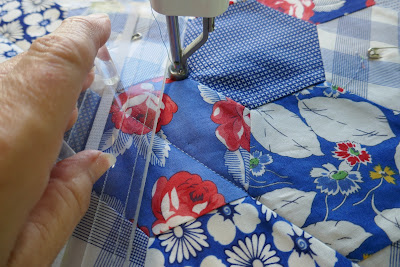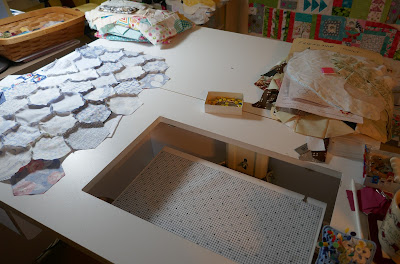The cool weather has arrived here in Northeast Ohio. While we haven't had a frost along the Lake Erie shoreline (one of the perks of living here), we had a cool enough night the beginning of the week to send me rushing outside at 9:30 p.m. to grab plants and bring them inside on an impulse!
I promised myself in the spring, I wouldn't keep so much over the winter this year.
We'll see?
I finished the scrappy blue hexagon quilt this week!
The "tall ships" backing is from deep in my stash and I picked a red-orange binding because there was no way I'd be able to match these blues (in my stash anyway).
I know for sure of one person who stitched along with me but quite a few of you took advantage of the special on Set-In Piecing Simplified -- so book mark this series of posts and plan to try it this winter! If you did stitch along, you might want to read through all the posts gathered under the tab at the top of the page "Diamond Star Playtime Sew-Along".
It will give you lots of ideas of other ways to use this technique!
The texture of the quilting is perfect. I used Quilters Dream Machine Blend and my version is 36" by 47" using a 2" finished hexagon.
Stepping up to a bigger hexagon would expand the size quickly and still use the same number of hexagons. For example, 4" hexagons would yield a 70" by 92" -- I'm thinking about all the florals in my stash and how pretty that would be!!
This quilt top is finished and the backing prepped!!
Yea, yea, yea!!!
It's my version of #100days100blocks2019 which just wrapped up on Instagram and Facebook last week. If you are regretting not jumping on this sewalong, Angie @gnomeangel has just announced she will repeat the Kinship Sampler in 2020 -- you can sign up HERE for her newsletter.
Most of the piecing is simple and I pulled 85% of the fabrics from my stash.
(That computes to using up 8 yards of stash - top and backing!!)
This is destined for one of my grand-daughters when they graduate to "big girl" beds and now I'm finishing this Rose Star top from a couple years ago for the other one. It just needs borders.
It's been sitting on my sewing table with it's pile of fabrics waiting for borders for months. Part of the hold-up has been that the "perfect border fabric" isn't quite enough, so this week I started piecing some little 6-pointed stars to use for cornerstones and "stretch" that ideal print. It's likely the girls will be sharing a room as they grow up and these two quilts will be good companions.
Don't worry, there's one underway for their brother!!
All this progress in the studio has put me into the mood to focus on some UFO's and finish up as much as I can before the end of the year. My Dodecagon quilt is at the top of that list and is currently occupying one corner of the living room so I can't ignore it!
I'm also determined to finish the last two tiles for the #sharksdinnerBOM on time (the end of November) and figure out my setting plan.
This is the October tile -- fabric auditioning is finished and the basting is well underway!
Loving this fabric combination!!
The garden activities are slowing down -- the only thing still blooming in my yard are zinnias and mums -- the insects have been enjoying them on sunny days. I was thrilled to spot this Buckeye butterfly along with four other species earlier in the week!
And just today, I found this intriguing spider!!
Eating a fly.
I-naturalist tells me it's a juvenile Bold Jumping Spider.
The fly is the lower half of the "bug" mash-up.
I'm pleased with my quick transition to the next project -- usually when I finish something, it feels like I'm spinning and may take me several days to transfer my attention to the next "thing".
But there's no time to be lost this year -- I have "ambitious" Christmas knitting plans.
Even the sewer back-up in the basement yesterday (it was minimal) didn't slow me down!!
The sun is shining here and I hope it shines for you this weekend!!
Mary








































